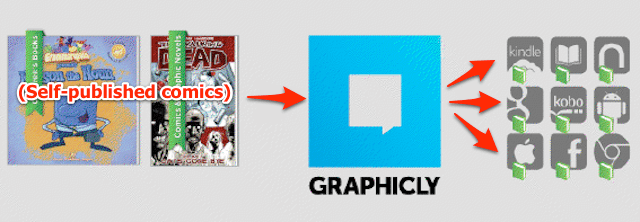
While technology has certainly made it easier for people to self-publish comic books or graphic novels, the same isn’t true when it comes to digital distribution — or getting self-published “indie” comic books into multiple online stores so people can buy them.
[aditude-amp id="flyingcarpet" targeting='{"env":"staging","page_type":"article","post_id":381504,"post_type":"story","post_chan":"none","tags":null,"ai":false,"category":"none","all_categories":"business,media,","session":"B"}']The lack of affordable distribution options for self-published comic books makes it difficult for creators to turn their work into a business. But with over 300,000 self-published creators expected to begin selling their own comic books and graphic novels in 2012, digital comic book startup Graphicly sees a huge opportunity for growth.
In addition to Graphicly’s web and Facebook distribution channels, the company recently opened up its platform for self-published comic book creators to sell their work across several different digital bookstores, including Apple’s iBookstore, Amazon’s Kindle store, the Android Market, Barnes & Noble, and others. Creators pay an initial “conversion fee” for each comic book they want to distribute, and retain most or all of the revenue depending on the distribution channel. Sales made through Graphicly’s online store or integrated Facebook store are free, but sales through channels like the iBookstore still incur a revenue sharing fee.
AI Weekly
The must-read newsletter for AI and Big Data industry written by Khari Johnson, Kyle Wiggers, and Seth Colaner.
Included with VentureBeat Insider and VentureBeat VIP memberships.
Considering the extremely high costs associated with making a single self-published comic book series available across all of the aforementioned stores/platforms, Graphicly’s “distribution as a service” model makes perfect sense for most self-publishers. The company estimates that it can implement a new comic book into all the appropriate distribution channels a week after receiving a PDF file of the book itself.
“From our initial testing with the analytics tools we discovered that most people read an average of 3 to 4 minutes for each full length comic book before putting it down,” Baldwin said in an interview with VentureBeat.
Having been a serious comic book reader for decades, I determined that this length of time is roughly about how long people need something to read while sitting on the toilet. And while Baldwin jokingly agreed, he went on to explain how future creators might want to publish a new issue after three or four pages rather than the currently industry standard of 22-pages per monthly comic book.
“The only reason 22-pages is the standard length of a comic book is because most artists can typically finish drawing one page per day… So, 22 pages spread out over the entire month, they would have enough time to finish the whole issue,” he said.
For example, if a self-published comic book creator determined that people only read five pages at a time based on Graphicly’s analytics, it might change the frequency of distribution. That in turn might improve reader engagement, which could impact sales.
[aditude-amp id="medium1" targeting='{"env":"staging","page_type":"article","post_id":381504,"post_type":"story","post_chan":"none","tags":null,"ai":false,"category":"none","all_categories":"business,media,","session":"B"}']
Why Graphicly’s self-publishing model will disrupt the comic book industry
Previously, Graphicly concentrated on its own distribution channel for a handful of major comic book publishers like Image, Marvel and IDW, as well as a variety of smaller and creator-owned publishers. The distribution channel can be integrated within a Facebook company page or official website, which gives it an advantage over competitors like comiXology because it combines the marketing efforts of publishers with Graphicly’s own promotional efforts. Graphicly generates revenue by taking a cut from each comic book sale, much in the same way that both Apple and Amazon do with their respective digital book stores.
The inherent problem with this strategy is that people inevitably favor the platform with the most “complete” collection of media in its library, which often contains exclusive content unavailable to competitors. For example, Netflix has the largest library of streaming video content and the most streaming video subscribers. As for digital comic books, comiXology has the largest selection of content from all the major publishers and likely the highest base of customers among digital comic book distribution channels. While Graphicly has more content available by a much larger number of publishers, it still lacks inventory from DC Comics, which brings in the majority of all comic book sales (digital and print). And since digital purchases are only stored within each individual distributor’s platform, its likely that people will end up choosing the platform with the most complete selection of content available for purchase.
“The beauty of this model is that we don’t need DC Comics to succeed,” Baldwin said. “Hopefully, DC and other big publishers will eventually see the value of Graphicly’s distribution and analytics,” which will bring them on board, he added.
[aditude-amp id="medium2" targeting='{"env":"staging","page_type":"article","post_id":381504,"post_type":"story","post_chan":"none","tags":null,"ai":false,"category":"none","all_categories":"business,media,","session":"B"}']
Essentially, if you can generate at least $150 in sales from your self-published comic book, you are earning a return — excluding any other operating costs. And since the Graphicly platform makes the book available on all major digital bookstores it improves the possibility for higher sales. Compared to printing costs, the “conversion fee” is also a cheaper means of distribution — making it possible for more independent creators to publish books. (It’s worth noting that Baldwin said the $150 fee is “beta pricing” and will likely change to better fit the needs of each small publisher as the platform gains steam.)
The new publishing platform is available to current Graphicly publishers, with a full roll out coming in the next few weeks.
The Boulder, Colorado-based startup closed a $3 million funding round in January 2011 led by DFJ Mercury, with participation from 500 Startups, Dundee VC, Ludlow Ventures, and individual angel investors. The company was incubated by TechStars and previously raised $1.2 million from DFJ Mercury and others. It has 20 employees and has raised a total $4.2 million to date.
VentureBeat's mission is to be a digital town square for technical decision-makers to gain knowledge about transformative enterprise technology and transact. Learn More